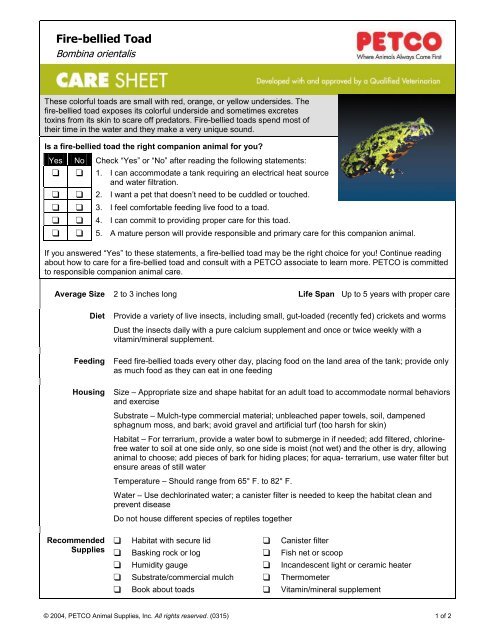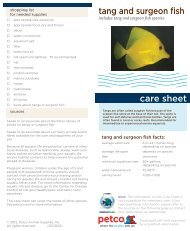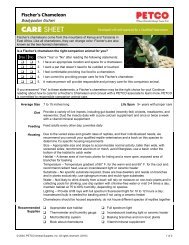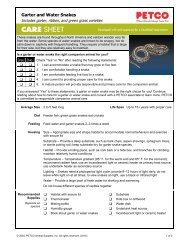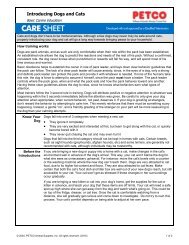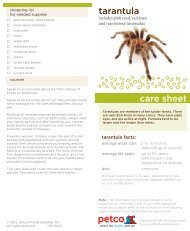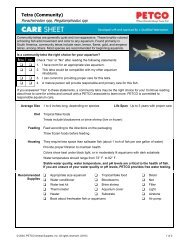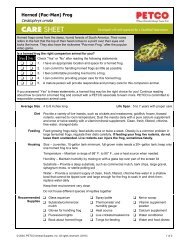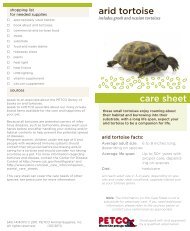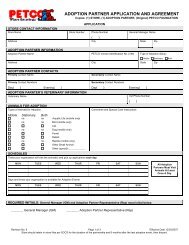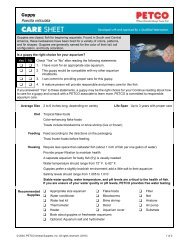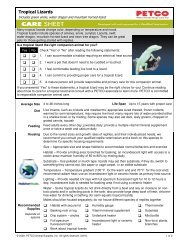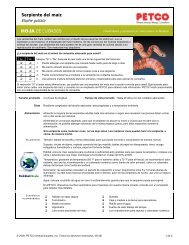You also want an ePaper? Increase the reach of your titles
YUMPU automatically turns print PDFs into web optimized ePapers that Google loves.
<strong>Fire</strong>-<strong>bellied</strong> <strong>Toad</strong><br />
Bombina orientalis<br />
These colorful toads are small with red, orange, or yellow undersides. The<br />
fire-<strong>bellied</strong> toad exposes its colorful underside and sometimes excretes<br />
toxins from its skin to scare off predators. <strong>Fire</strong>-<strong>bellied</strong> toads spend most of<br />
their time in the water and they make a very unique sound.<br />
Is a fire-<strong>bellied</strong> toad the right companion animal for you?<br />
Yes No Check “Yes” or “No” after reading the following statements:<br />
❑ ❑ 1. I can accommodate a tank requiring an electrical heat source<br />
and water filtration.<br />
❑ ❑ 2. I want a pet that doesn’t need to be cuddled or touched.<br />
❑ ❑ 3. I feel comfortable feeding live food to a toad.<br />
❑ ❑ 4. I can commit to providing proper care for this toad.<br />
❑ ❑ 5. A mature person will provide responsible and primary care for this companion animal.<br />
If you answered “Yes” to these statements, a fire-<strong>bellied</strong> toad may be the right choice for you! Continue reading<br />
about how to care for a fire-<strong>bellied</strong> toad and consult with a PETCO associate to learn more. PETCO is committed<br />
to responsible companion animal care.<br />
Average Size 2 to 3 inches long Life Span Up to 5 years with proper care<br />
Diet<br />
Provide a variety of live insects, including small, gut-loaded (recently fed) crickets and worms<br />
Dust the insects daily with a pure calcium supplement and once or twice weekly with a<br />
vitamin/mineral supplement.<br />
Feeding<br />
Housing<br />
Feed fire-<strong>bellied</strong> toads every other day, placing food on the land area of the tank; provide only<br />
as much food as they can eat in one feeding<br />
Size – Appropriate size and shape habitat for an adult toad to accommodate normal behaviors<br />
and exercise<br />
Substrate – Mulch-type commercial material; unbleached paper towels, soil, dampened<br />
sphagnum moss, and bark; avoid gravel and artificial turf (too harsh for skin)<br />
Habitat – For terrarium, provide a water bowl to submerge in if needed; add filtered, chlorinefree<br />
water to soil at one side only, so one side is moist (not wet) and the other is dry, allowing<br />
animal to choose; add pieces of bark for hiding places; for aqua- terrarium, use water filter but<br />
ensure areas of still water<br />
Temperature – Should range from 65° F. to 82° F.<br />
Water – Use dechlorinated water; a canister filter is needed to keep the habitat clean and<br />
prevent disease<br />
Do not house different species of reptiles together<br />
Recommended<br />
Supplies<br />
❑ Habitat with secure lid ❑ Canister filter<br />
❑ Basking rock or log ❑ Fish net or scoop<br />
❑ Humidity gauge ❑ Incandescent light or ceramic heater<br />
❑ Substrate/commercial mulch ❑ Thermometer<br />
❑ Book about toads ❑ Vitamin/mineral supplement<br />
© 2004, PETCO Animal Supplies, Inc. All rights reserved. (0315) 1 of 2
<strong>Fire</strong>-<strong>bellied</strong> <strong>Toad</strong><br />
Bombina orientalis<br />
Normal<br />
Behavior and<br />
Interaction<br />
Habitat<br />
Maintenance<br />
Grooming<br />
and Hygiene<br />
Signs of a<br />
Healthy Animal<br />
Common<br />
Health Issues<br />
<strong>Fire</strong>-<strong>bellied</strong> toads spend most of their time in the water; Males call when they are ready to<br />
breed; the call is quite unusual, sounding like a dog’s bark; They recognize routine; feed them<br />
at the same time every day and you’ll find them waiting; One of the few communal toads, they<br />
live together in the wild<br />
Remove left over food and feces daily to keep the water clean and clear<br />
Use an appropriate sized, small-mesh, soft net to move or block the toad while doing habitat<br />
maintenance; avoid handling; if you handle them be sure to wear latex gloves; residue or oil<br />
on your skin can harm amphibians<br />
Thoroughly clean the tank at least once week: set toads aside in a secure habitat; scrub the<br />
tank and furnishings with a 3% bleach solution; rinse thoroughly with water, removing all smell<br />
of bleach; add clean, dechlorinated water; ensure temperature range is from 75° F. to 85°F<br />
before returning toads to the tank<br />
Don’t handle unless necessary; wear latex gloves; do not allow toad’s skin toxins into contact<br />
with eyes, mouth, or open wounds<br />
Always wear latex gloves if you must handle your toad and wash your hands after handling<br />
the habitat contents to help prevent Salmonella and other infectious diseases<br />
Active and alert Eats regularly<br />
Healthy skin Clear nose and vent<br />
Clear eyes Hopping and swimming<br />
Health Issue (alpha) Symptoms or Causes Suggested Action<br />
Chemical<br />
Intoxication<br />
Intestinal<br />
Obstruction<br />
Nutritional<br />
Deficiencies<br />
Skin Problems<br />
Caused by exposure to soap,<br />
detergent, pesticides, etc.<br />
Caused by swallowing gravel<br />
or by eating too many hardshelled<br />
insects.<br />
Weak hind legs, lethargy,<br />
lighter or darker skin color.<br />
Abrasions, bacterial and<br />
fungal infections.<br />
May be lethal; be sure to protect<br />
your frog from exposure.<br />
Consult with an exotic animal<br />
veterinarian; surgery may be<br />
required.<br />
Ensure a varied diet; use vitamin<br />
and mineral supplements. Consult<br />
with an exotic animal veterinarian.<br />
Consult with an exotic animal<br />
veterinarian for treatment.<br />
Red Flags<br />
Sources<br />
Lethargy Skin lesions<br />
Loss of appetite Distressed breathing<br />
Weight loss Weak leg movements<br />
<br />
Bloated abdomen<br />
If you notice any of these signs, please contact your exotic animal veterinarian.<br />
Frogs and <strong>Toad</strong>s by Steve Grenard and Terry Gamppen<br />
Frogs and <strong>Toad</strong>s as New Pets by John Coborn<br />
Note: The information on this Care Sheet is not a substitute for veterinary care. If you need additional<br />
information, please refer to the above sources or contact your veterinarian as appropriate.<br />
2 of 2 SKU 926639 © 2004, PETCO Animal Supplies, Inc. All rights reserved. (0315)


